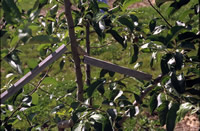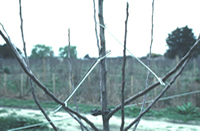Q. We have a Honeycrisp apple tree that is 2-3 years old. It is growing well, but straight up. It has approximately doubled in height in the year since we planted it. My question is: Can I prune the top back to make the tree less tall and bushier? I know not to do that with maple trees, but don’t know about apple trees.
A. The quick answer is do NOT prune the top; this would promote excessive branching and delay the development of flowering buds and fruiting. The ultimate mature height of apple trees is determined by the specific rootstock that is used when the tree is grafted at the nursery.
It is important to get apple branches to lay more horizontal to encourage development of flower buds in future years and less leafy upright shoots. Just like with kids and dogs, you want to start training your tree while it’s young, before it has a chance
to develop bad habits! Aim to develop 3-5 main branches, starting at two feet above the ground and spaced around all sides of the tree. You can help encourage wide angles (about 45 degrees) by tying or bracing with wooden or plastic sticks lodged between the trunk and the branch. This allows more room for side branches and more fruiting wood. Ideally, this training is started during the first growing season, but it’s not too late. Late winter – once the sap is flowing – is the ideal time as the branches are more pliable. See photos for examples. Photos courtesy Peter Hirst / Purdue University
Additional information on pruning and training apple trees is located athttp://www.hort.purdue.edu/ext/prunehomeorchard.html. The Midwest Home Fruit Production Guide has excellent information for home fruit growers, http://estore.osu-extension.org/productdetails.cfm?PC=2337. Penn State Extension also has an informative website on pruning apples, http://extension.psu.edu/plants/gardening/fphg/pome/pruning.
Q. The last couple years my maple tree has developed ink black spots on its leaves. The spots look like drops of tar and go through the leaf. Also, the leaves on my basil plant are getting black spots. They are situated about 10 feet from each other. Could this be the same thing?
A. The spots on the maple and basil plants are not likely related. Most plant diseases are more host-specific, meaning they usually infect a particular species or closely related species. However, conditions such as wet weather, high humidity and poor air circulation could simultaneously foster development of several diseases. There is a fungal disease of maple called tar spot; it’s mostly a cosmetic problem and does not cause serious harm. There are other diseases that can cause black spots on maples, but they are unlikely to look like tar. Additional info on tar spot can be found athttp://www.ppdl.purdue.edu/PPDL/weeklypics/1-19-09.html.
There are a number of diseases that could cause black spots on basil and can be caused by either fungi or bacteria. If you have problems with the basil spots again next year, you might consider sending a sample to the Purdue Plant and Pest Diagnostic Laboratory to get an accurate diagnosis and treatment recommendations. Information on how to submit samples is located at www.ppdl.purdue.edu.

